Table of Contents
- What is a sales playbook?
- What is a sales play?
- 7 Sales Playbook Templates to Help You Close More Deals
- How to Create a Sales Playbook That Closes More Q4 Deals
- What to Include in a Sales Playbook
- Benefits of a Sales Playbook
- Sales Plays to Include in Your Playbook
- Winning Tips for Crushing Q4 Sales Goals
- Sales Playbook Examples
What is a sales playbook?
A playbook is a comprehensive guide that outlines the best practices, strategies, and processes for achieving specific goals within an organization.
In the context of sales, a playbook serves as a detailed manual that helps sales teams navigate common scenarios they encounter during the sales process. It provides step-by-step instructions, proven techniques, and helpful resources to ensure consistent, effective sales approaches that motivate buyers and help sellers to destress.
Great sales playbooks include sales enablement tools like:
- Value-based selling cheat sheets and customer quotes.
- Strategy steps.
- Discovery call questions.
- ROI-related data.
- Buyer personas.
- Sales process rules.
- Competitive battle cards.
- Email and social media templates and ideas.
- Call scripts and outlines.
What is a sales play?
A sales play is a set of repeatable steps, actions, and best practices for sales reps to use during a specific stage of the sales process. Sales reps can use them to move deals forward without brainstorming new strategies, and customers receive consistent service as a result.
A play is a specific strategy or set of actions designed to achieve a particular objective.
In a sales context, it’s a tactical approach that sales teams use to engage prospects, address their needs, and move them through the sales funnel. Sales plays are tailored to different scenarios, customer segments, or stages in the buying process. They are meant to provide you with a clear, actionable plan. In other words, if a sales playbook is a manual, a sales play is a specific tutorial within the manual.
Pro tip: While a defined sales play provides structure, it shouldn't be rigid. I recommend that teams regularly review and adapt plays based on real-world results and changing market conditions.
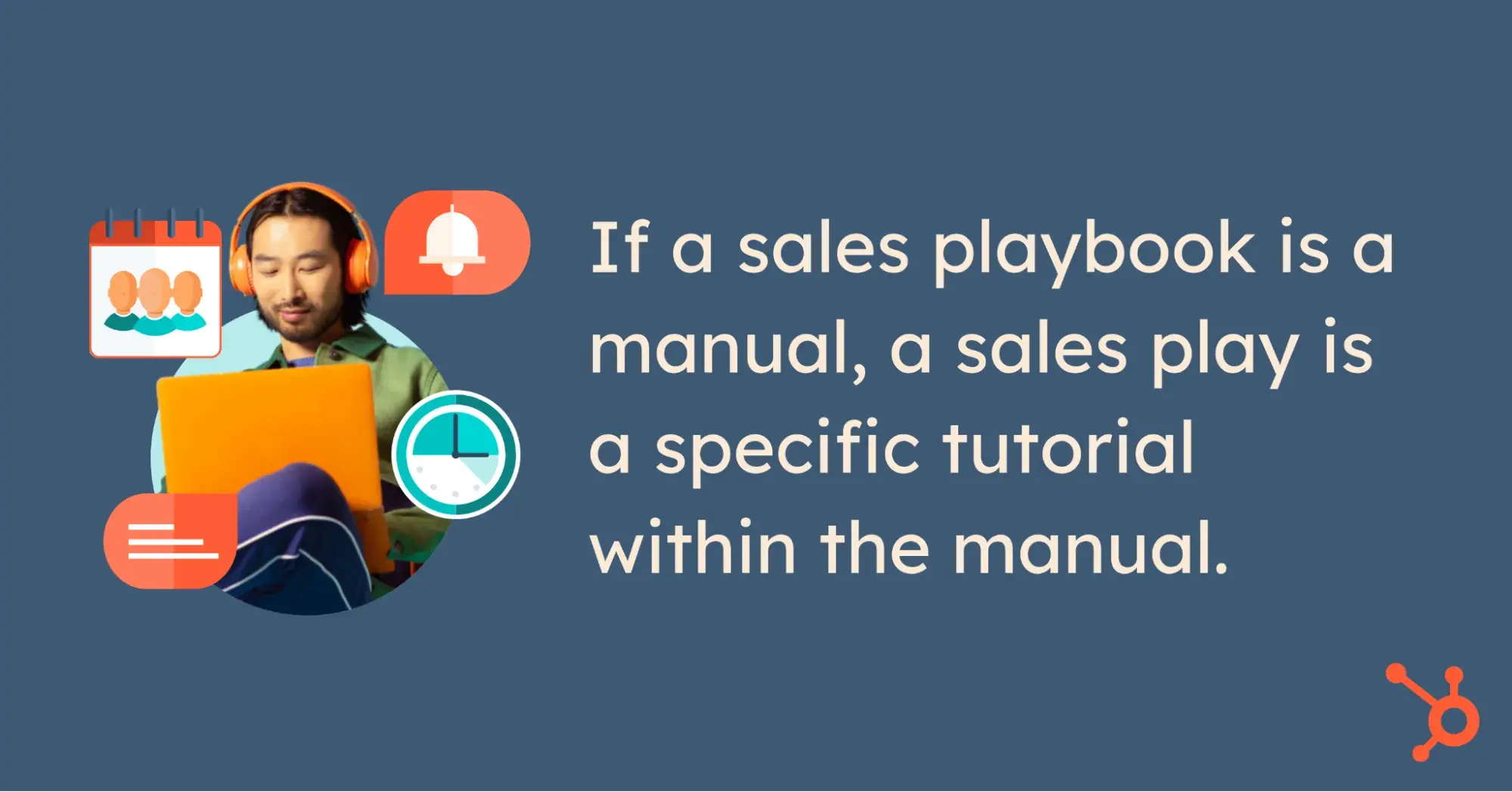
Key components of a sales play typically include:
- Objectives.
- Target audience.
- Messaging ideas.
- Steps and actions.
- Tools and resources.
- Metrics and KPIs.
Why Your Business Needs a Sales Playbook
Many companies talk about the value of having a “single source of truth” for important company matters. A sales playbook can be that source of truth — and a treasure trove of resources for sales processes, competitive information, shortcuts to closing deals, and succeeding as a trusted advisor to prospects, partners, and customers.
Even on days when sales reps aren’t at the top of their game, a playbook can point them in the right direction and help them meet goals like quota and lead conversion rates.
Your sales leaders and longest tenured sales representatives have a lot of expertise that they’ve developed over the years. I recommend collecting that expertise into a shareable living document and connecting the dots between tried and true sales tactics and resources in book form can be invaluable for future growth.
7 Sales Playbook Templates to Help You Close More Deals
When you're in the final quarter, every sale counts. You need proven, reliable strategies to guide your team and ensure they can apply the playbook effectively during every stage of the sales process.
As a senior business development and sales and marketing professional, I’ve noticed that playbook templates help ensure your enablement materials are:
- Effective and based on actual selling experiences, not theory.
- Comprehensive yet digestible enough to use on the go.
- Offer targeted content for specific industries and personas.
- Kept current with the latest product features, benefits, and changing customer priorities.
For instance, HubSpot offers sales playbook software which is integrated into the Sales Hub platform. This tool is designed to help you create, manage, and utilize playbooks effectively to improve your sales processes. Accessibility through Sales Hub makes playbooks simple to find when needed no matter where your business day takes you.
The sales playbook application offers ready-to-use templates for various scenarios, such as:
- Discovery calls.
- Qualification calls.
- Prospecting.
- Client meetings.
- Follow-up email messages.
Here are my favorite playbook templates.
1. Sales Plan Template by HubSpot
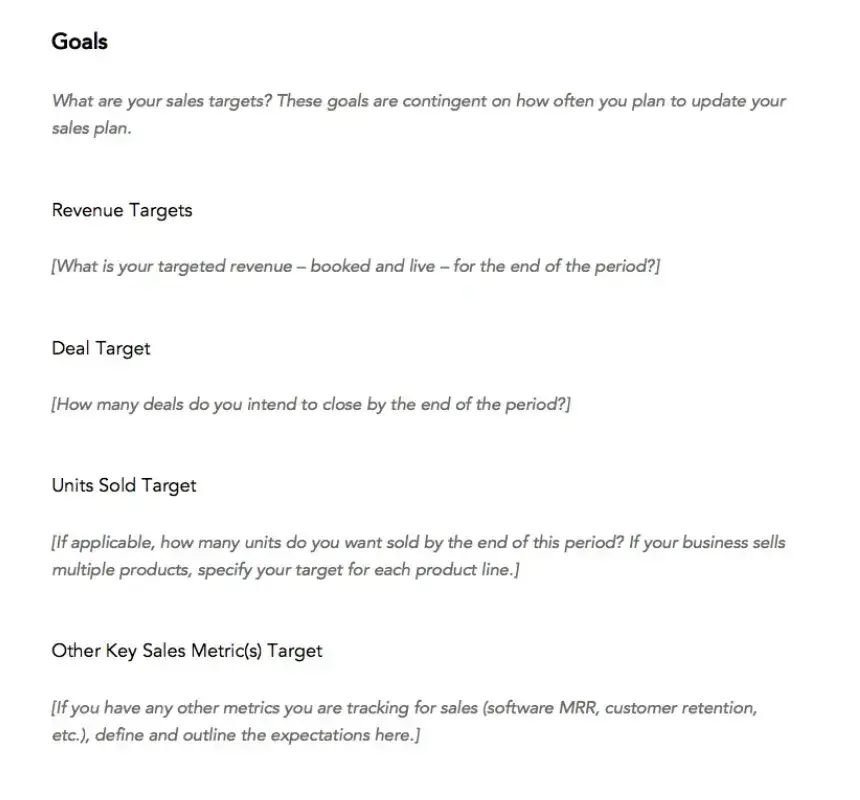
This customizable template allows you to work through your sales plan and playbook simultaneously so they align with each other. I recommend using this template as a foundation before you create the more advanced sections of your playbook. You can easily adapt it as your business, and your playbook evolves.
Pro tip: Your sales plan should inform your playbook, and your plays should align with the goals outlined in your sales plan. That’s why I suggest creating your sales plan first and sharing it with your team before creating and sharing other playbooks.
2. Sales Call Scripts by HubSpot
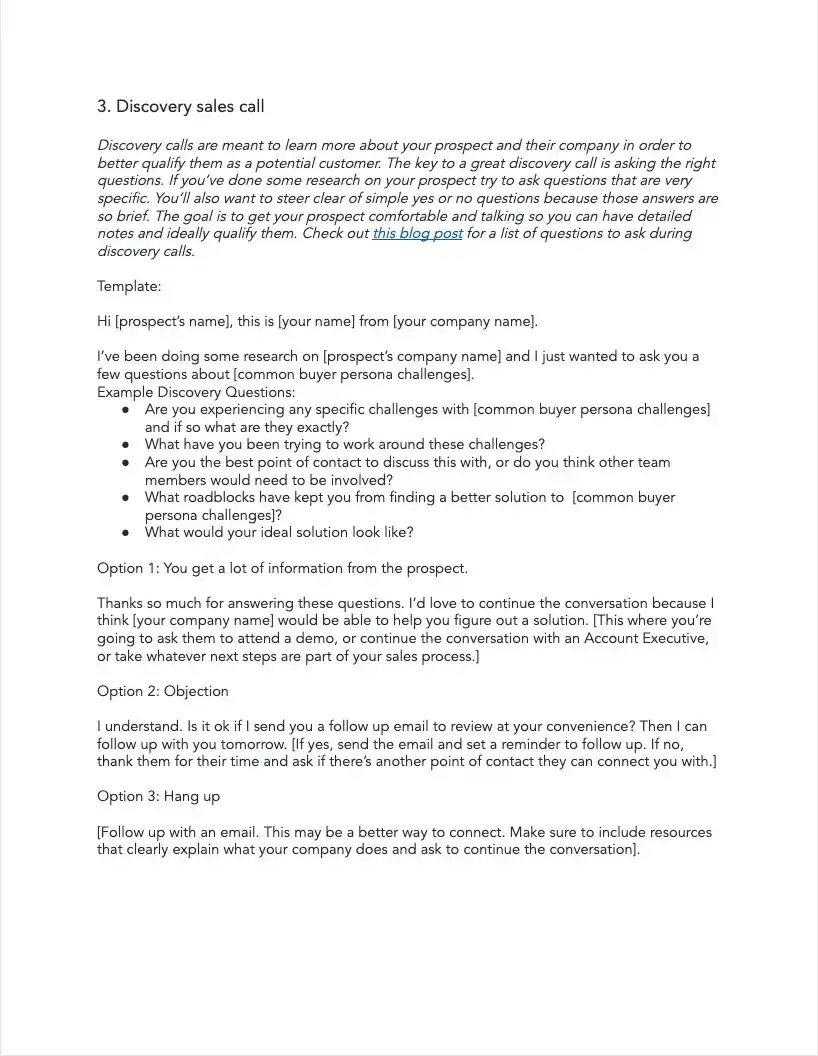
Include script templates in your playbook to ensure your team is prepared to enhance their conversations with customers and prospects. These scripts should be conversational, compelling, and used consistently for engaging sales calls, while preparing your sales team to increase their Closed/Won deal numbers.
Pro tip: I never read sales scripts verbatim during calls, but always found they were a great way to sort out what to say when opening a sales call.
HubSpot's sales call scripts provide structured templates for various scenarios, from cold calls to follow-up conversations. It includes several types of call scenarios, including:
- Standard outreach.
- Gatekeeper.
- Discovery discussions.
- Navigating referral or recommendation redirects.
- Introductory or renewing connections.
- Proposal and prior meeting follow-ups.
What I like: Each template explains its best use cases and provides different options, depending on whether the prospect is willing to chat, or if they’d prefer to reconnect next year.
3. Sales Email Templates by HubSpot
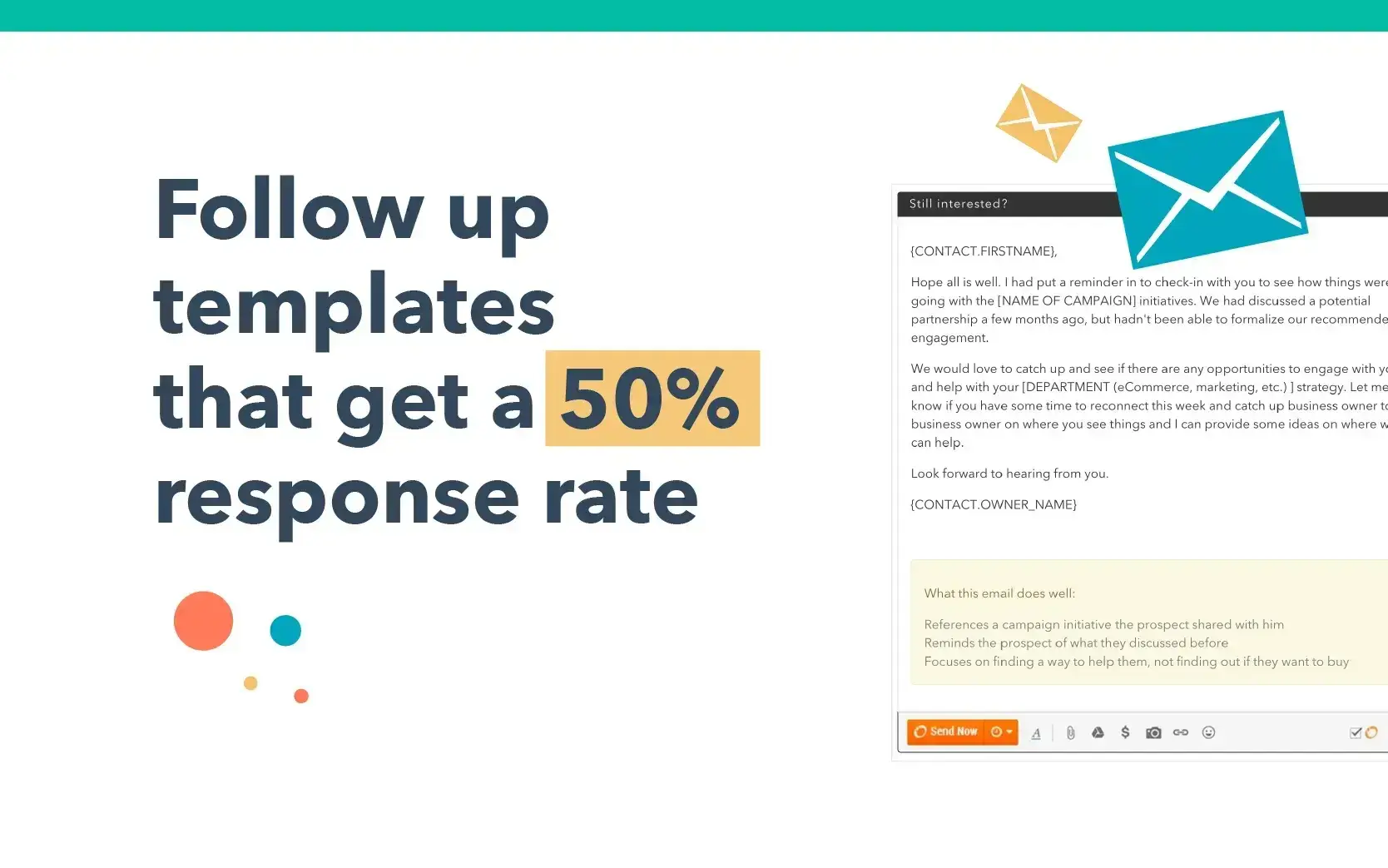
Email will always remain a powerful, non-intrusive tool for reaching prospects. This sales email template kit includes emails for just about every scenario there is, including:
- First-touch introductions.
- Break-up messages for ending on a high note.
- Post-voicemail “just called you” explanations.
- Drip campaign emails.
- Deal win or loss debrief invitations.
What I like: Your sales team won't have to write an email from scratch again, which saves time that can be better spent researching prospects and closing deals. I often found it awkward to write a follow up email after I lost a deal, or even when I won. Yet, debrief conversations are often excellent resources for learning how to navigate similar selling scenarios. I suggest you store that one in your end of year follow-up files to prepare for the coming year.
4. Sales Qualification Questions by HubSpot
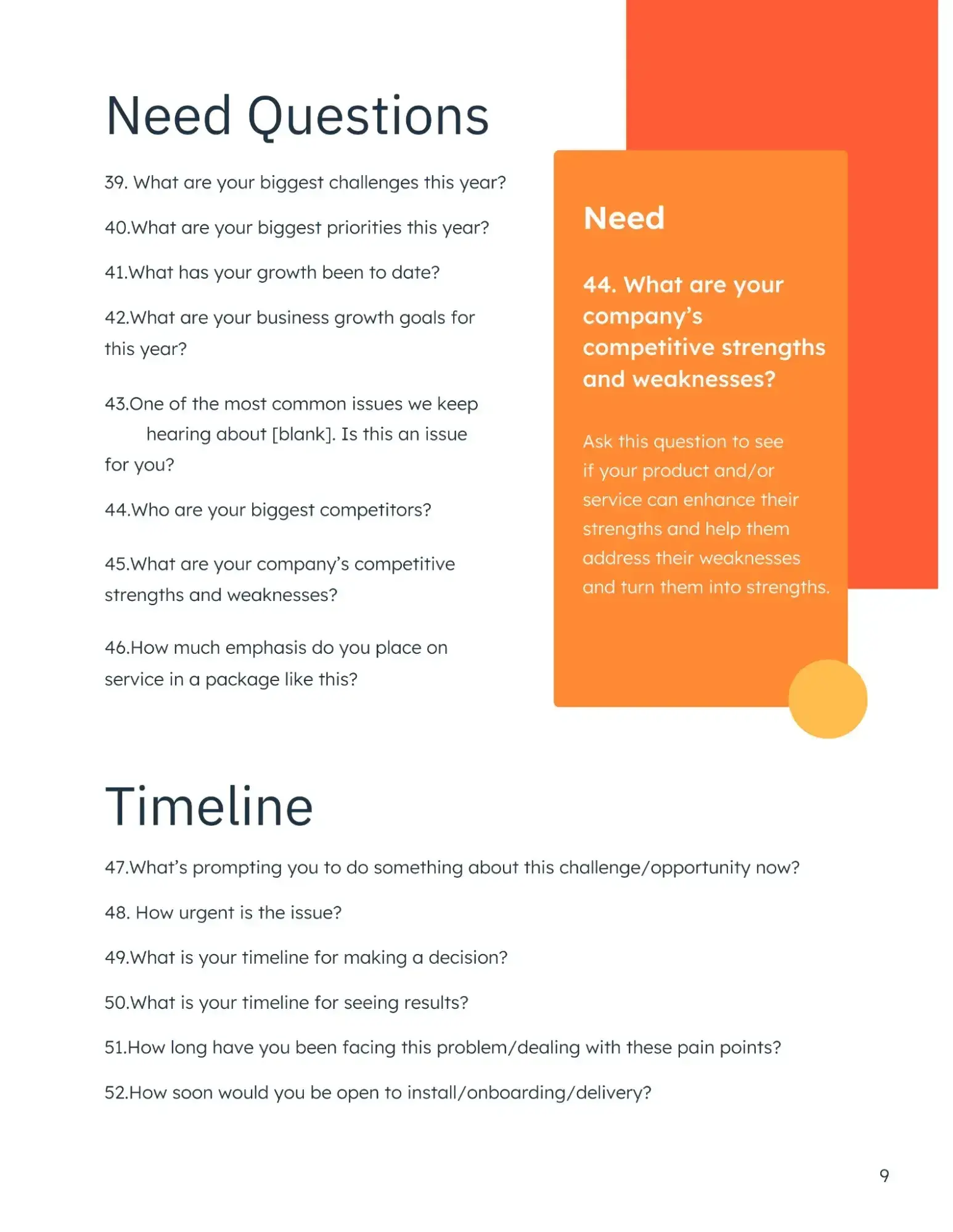
Qualifying leads is essential to focus your efforts on the most promising prospects. HubSpot’s list of sales qualification questions allows you or your team to discover your lead’s level of awareness and need, as well as their budget, timeline, and expected business impact from the purchase.
What I like: Although I often found extended silences can be an advantage during sales calls, it’s great to have a fresh arsenal of probing questions in your playbook. It can empower your team to better nurture promising prospects, improve their sales qualification effectiveness, and help move deals through the sales pipeline.
5. Prospecting & Objection Handling Templates by HubSpot
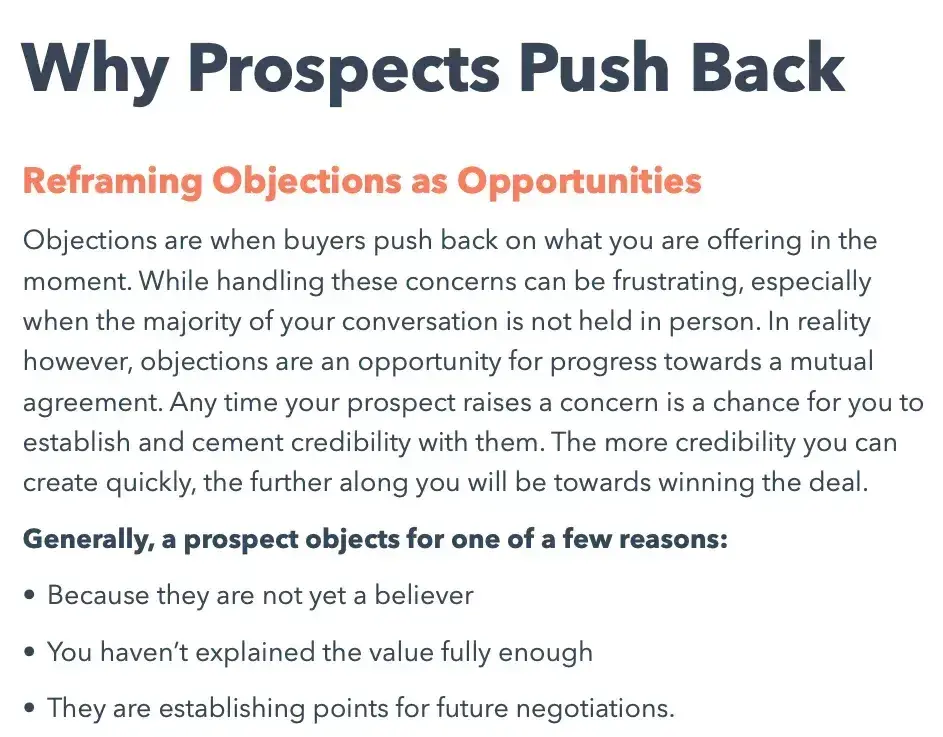
During every sales process, salespeople are bound to run into objections. Your sales playbook should include objection handling tips and methods for when they arise. Prospects always have at least a few objections in every sales engagement, otherwise successful businesses wouldn’t need to hire high-performance sales representatives of the caliber they do.
These objection-handling templates and best practices are a worthy addition to any sales playbook and provide strategies and responses for common objections. I like how this guide provides sales reps with techniques for addressing concerns professionally and keeping the conversation moving forward.
There are also some good insights on why prospects push back, and about keeping a repository of proven objection rebuttals. That way, salespeople can handle objections with politeness and empathy while dispelling a prospect’s reservations and fears.
6. Sales Battle Card Templates by HubSpot
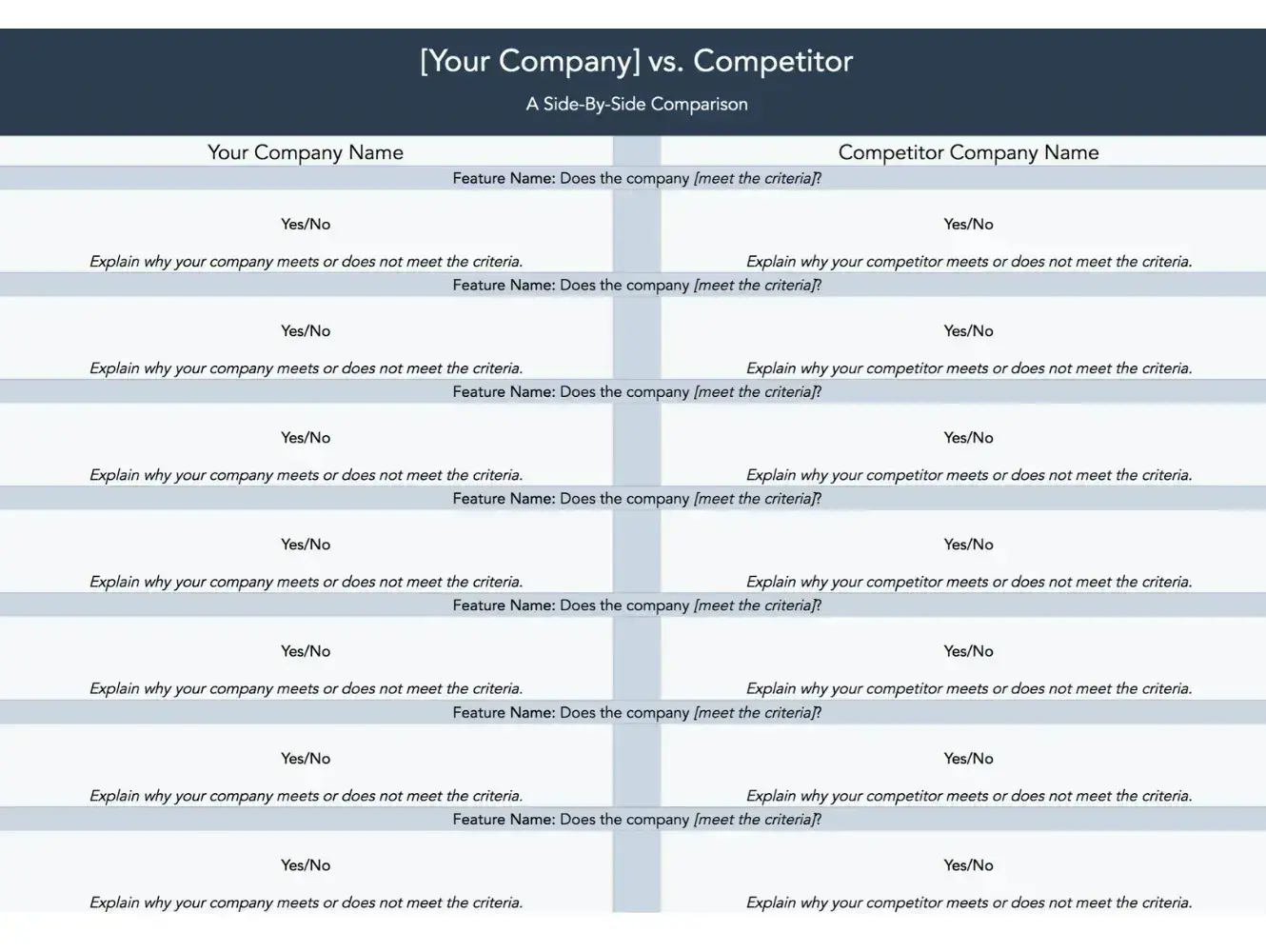
At one point or another, your prospects will challenge your sales team about a competitor’s features, pricing, benefits, or other factors. Whether they are currently using a competitive solution, or considering marketspace alternatives, you want your team to confidently position your strengths and strategic value relative to your competition.
The company I work for now — and most that I’ve worked for in my career — have a non-disparage policy about competitive sales. I read a great Klue article on selling competitively by focusing on your strengths and driving a value wedge with your company’s products or service to distinguish your offerings from your competitors.
These HubSpot battle card templates will help your team better understand your market positioning and handle objections more effectively. They enable your sales operations, product management or competitive intelligence team document and share competitive intelligence across your sales and marketing teams, including their strengths, weaknesses, and key differentiators. They can enable your sales team to better position your product, highlight unique value propositions, and counter competitive threats.
Pro tip: Work with your colleagues across your business to curate competitive data points from sources like reputable analyst reports and review websites. Protect your customers from churning and maintain your edge in competitive sales pursuits. Task your sales team to tactfully ask customers what they like and dislike about competitive solutions. Add these points your sales playbook, and empower your reps to use them to win more deals.
7. Sales Closing Guide by HubSpot
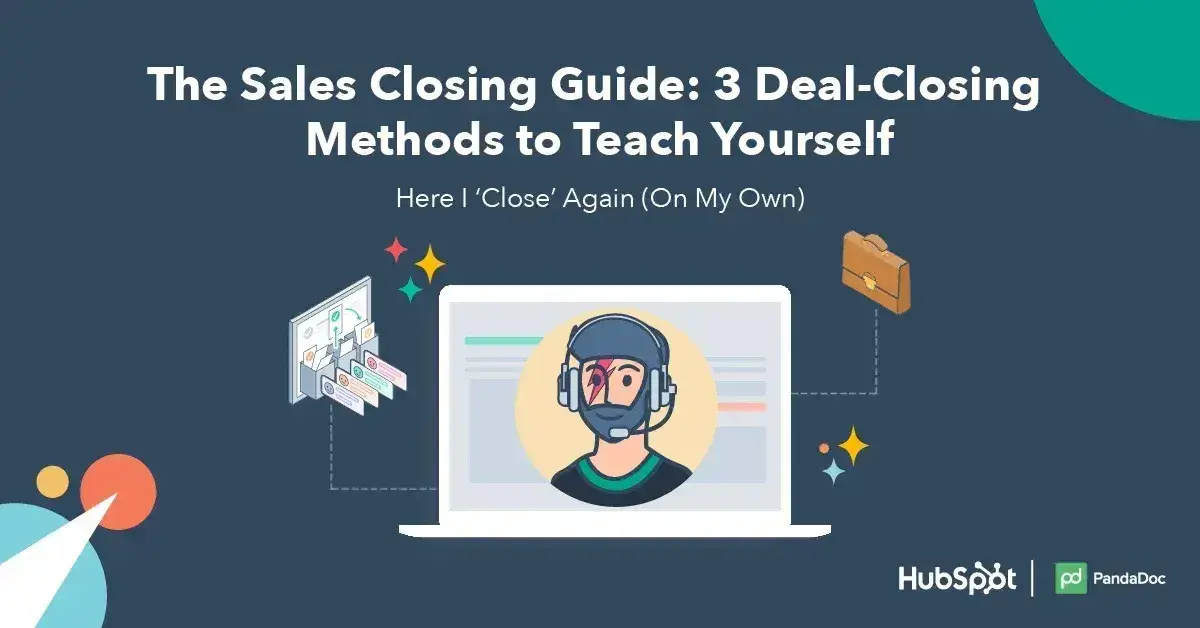
From my experience, the most important piece of information you can include in your playbook is how to close deals. This sales closing guide from HubSpot offers a step-by-step approach to sealing the deal, including techniques for:
- Creating urgency.
- Handling last-minute objections.
- Negotiating terms.
It also offers tips on recognizing buying signals and timing your close.
What I like: I appreciate that you can include this guide directly in your playbook or share it individually with your sales team as a training tool they can reference from time to time. It’s an essential reference that will empower your people to close deals faster and more effectively.
How to Create a Sales Playbook That Closes More Q4 Deals
Your sales playbook is unique to your business. Here are steps you can take to create a sales playbook that will boost your closing rates and help you hit your targets.
Step 1. Define your sales process.
Start by mapping out each stage of your customer's journey, from initial contact to closing the deal and beyond. Identify key touchpoints, activities, and decision-making moments at each stage.
I’ve found that a visual representation of sales stages helped me to determine what I needed to do to nurture the deal forward. It also helps to strategically place trial close reminders because you never want to make a qualified prospect feel like you aren’t interested in their business.
Also, consider the pace at which deals move through your sales funnel and what actions best trigger forward progress. Identify and document the tools, resources, and skills needed at each stage. I recommend that you include both internal processes (like pricing approvals or contract reviews) and customer-facing interactions. My proposal development team has comprehensive standard operating procedures (SOPs) that make it clear how key tasks should be undertaken.
For instance, you can use the conversation intelligence tool to monitor your team’s call quality and your customers' tone of voice. There are a number of ways to use these insights during coaching meetings to help your reps better understand prospect requirements.
Pro tip: Creating a clear, step-by-step sales process outline can serve as the foundation for your entire sales playbook. It helps your team to develop a consistent and repeatable approach to guide prospects through the buying process.
How to Create a Sales Playbook (Guide)
Step 2. Develop winning sales strategies and define your key metrics.
Analyze your top performers' techniques and successful deals. Identify patterns and best practices for each stage of the sales process. Include effective methods for prospecting, qualifying leads, delivering compelling presentations, handling objections, and closing deals.
Back these strategies with data and real-world examples to demonstrate their effectiveness. To make them more effective, consider incorporating modern approaches like social selling, value-based selling, or solution selling.
Don't forget to outline strategies for different buyer personas and scenarios. The goal is to provide your team with a tailored toolkit of proven tactics to boost their success rates.
You should also determine the key performance indicators (KPIs) that will help you measure the success of your team’s sales efforts. This could include conversion rates, average deal size, sales cycle length, and customer acquisition cost.
In my experience: I enjoyed working on teams that prioritized these results-oriented metrics over activity-based metrics like call volume or lead resolution metrics. I appreciate, though, that if your conversion rates or deal closing numbers aren’t ideal, the activity metrics will demonstrate whether or not you are putting in the work required to succeed.
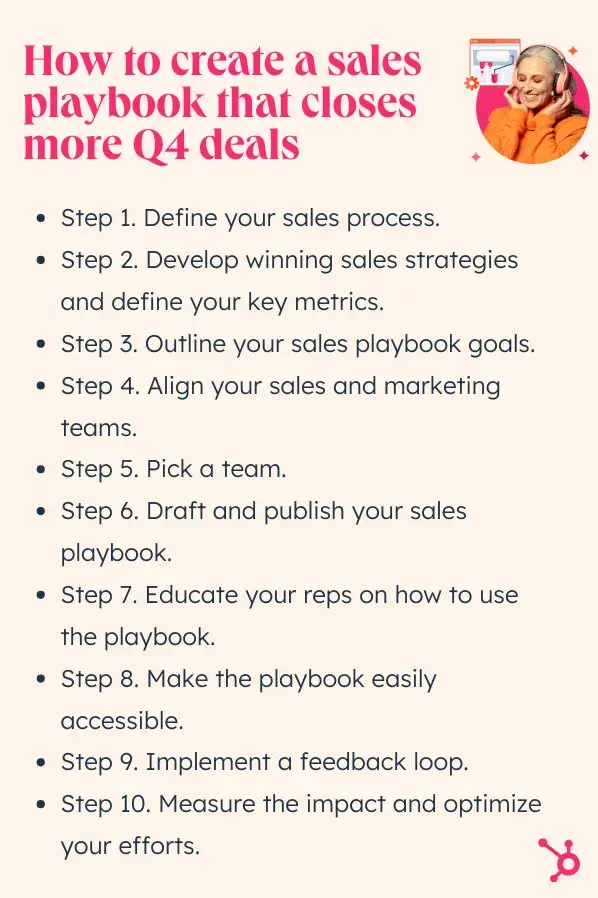
Step 3. Outline your sales playbook goals.
Use the KPIs from the previous step to identify specific, measurable objectives that align with your overall sales strategy. These goals should address key areas such as increasing revenue, improving conversion rates, shortening the sales cycle, or enhancing customer retention.
Once you identify your goals, define your short-term and long-term targets and ensure they are realistic and achievable. Your goals should also reflect the unique opportunities and challenges of your sales team’s skillset, what they sell, and how they fit into your company hierarchy.
Pro tip: Your goals should clearly illustrate individual performance targets, collaborative sales, and overall team attainment. Remember these goals will guide the content and structure of your playbook, so make them count.
Step 4. Align your sales and marketing teams.
Data shows that 90% of sales and marketing professionals feel they are out of sync in terms of strategy, process, content, and culture. Moreover, 60% believe this misalignment hurts financial performance. Clearly, this can hurt your sales strategy.
As someone who has worked in both sales and marketing, it’s often just a matter of one team reaching out to the other to initiate collaborative efforts, and for both teams to commit to working collaboratively towards common goals. Salespeople are great resources of campaign and content ideas from their customer conversations, and many marketing teams have a wealth of resources they can share to help move deals forward.
So, as part of developing your sales playbook, you need to ensure that your teams are in sync. This approach fosters a culture of mutual support and shared responsibility to create a cohesive and effective revenue-generating machine. Proper alignment can lead to significant benefits, including increased revenue growth, improved efficiency, enhanced lead quality, and a shortened sales cycle.
Good collaboration between the two teams results in a better understanding of your ideal customer, clearer mapping of the customer journey, and a more consistent message throughout the buyer's experience.
More importantly, you will need input from both teams to create a winning sales playbook that addresses the needs and challenges faced by each department.
Step 5. Pick a team.
Determine who should be involved in the sales playbook creation process so you can invite them to join collaborations.
Some of the teams I recommend tapping when building a playbook include:
- Sales reps (including account managers, sales specialists, and business development reps).
- Sales VPs, directors, and managers.
- Channel sales managers.
- Sales operations.
- Marketing personnel who work on content, product, and sales enablement materials.
- Product and service offering managers.
- Customer success and support teams.
- Industry principals and subject matter experts.
Having input from several customer facing and offering-related teams ensures your playbook reflects various aspects of the customer journey and sales process.
I also recommend identifying directly responsible individuals (DRIs) for creating the sales playbook so that other team members know who's leading the effort and who they can reach out to with questions and comments.
Step 6. Draft and publish your sales playbook.
This step is the climax of the whole process. Use all the data and insights you have gathered to put together your sales playbook. Remember those templates we talked about earlier? They're going to be your secret weapon here.
For instance, the sales plan template will help you lay out the big picture of your sales strategy. As you’re working through it, think about how you can tailor it to your specific product and market.
Pro tip: Remember, these templates are just starting points. The magic happens when you infuse them with your company's unique voice, experiences, and best practices. Don’t be afraid to get creative, but make sure it aligns with brand guidelines.
Step 7. Educate your reps on how to use the playbook.
In my experience, your sales playbook will only be effective if your reps are able to apply it effectively. They need to have a deep understanding of your products, their capabilities, and their features. They need to understand its ins and outs, including how to use customer voices for success.
That’s why I recommend hosting training sessions for my sales reps. They attend sessions with our company’s product teams and even test out products like customers. I suggest brainstorming ways you can get your team more familiar with your products so they know them inside and out.
Step 8. Make the playbook easily accessible.
To ensure your sales playbook is a valuable tool for your team, it must be easily accessible. This means storing it in a centralized, digital location where all sales reps can quickly find and use it. My team hosts these documents on a company Wiki. In the past, I’ve seen teams store this information on Google Drive and Atlassian. It all starts with accessibility — whether your playbook is in HTML or PDF, the format, locations, and access guidelines need to fit both the team’s and the organization’s needs.
Also, ensure that the playbook is mobile-friendly for on-the-go access and send regular email updates with direct links. This approach ensures everyone is well-equipped to follow best practices, practice consistent messaging, and maintain the efficacy of the playbook.
Step 9. Implement a feedback loop.
A robust feedback loop ensures your playbook remains a living, breathing document that evolves with your market, products, and team's expertise. It allows you to quickly identify and address gaps in your sales strategy, adapt to changing customer needs, and capitalize on emerging best practices.
This continuous improvement cycle can significantly boost your team's efficiency and effectiveness and, ultimately, your bottom line.
Therefore, encourage your team to share what’s working and what’s not and suggest updates to the playbook. Regular reviews and updates will keep your strategies fresh and effective.
Pro tip: Incorporate feedback into your playbook as part of your regular team meetings. This creates a culture of continuous improvement and ensures everyone is aligned with the latest strategies and practices.
Step 10. Measure the impact and optimize your efforts.
Finally, measure the impact of your sales playbook on your sales performance. Analyze the key metrics and KPIs to determine their effectiveness. Use this data to optimize your sales strategies and make necessary adjustments to the playbook.
Continuous monitoring and optimization will ensure that your sales playbook remains a valuable tool for closing more deals.
What to Include in a Sales Playbook
It's crucial to include specific components that address every aspect of the sales process to ensure your sales playbook becomes an indispensable resource for your team. In my research, I found that the following elements were most common in sales playbooks.
1. Company Overview
Provide a company overview and discuss the sales organization in detail. Include information about how the sales organization is constructed, who manages each team, which KPIs reps and teams are expected to hit, and so on.
2. Selected Plays
Identify which plays will be used for each playbook you create to clearly define the playbook's purpose for reps.
Ensure that each play is aligned with specific sales goals and scenarios your team encounters. Regularly review and update these plays to reflect new strategies and market changes, keeping your team agile and informed.
3. Products and Services Overview
Cover every product or service reps are responsible for selling. Mention price points, use cases, core value offerings, buyers, end-users, and related industries or verticals.
You may choose to create one sales playbook for each product you sell if they're all fairly different, require radically separate buying processes, have different buyer personas, or are sold by different members of your sales team.
4. Sales Process
Explain each step of your sales process from first touch to close. You might just link to your sales process document here so reps and sales managers can easily refer to it.
5. Playbook KPIs and Goals
Define the metrics that matter most for measuring success, such as conversion rates, average deal size, and sales cycle length. Set clear, achievable goals for each KPI.
Also, ensure that guidance is included on how to track and interpret these metrics and how they align with overall company objectives. This section should also outline any incentive structures tied to these KPIs.
Pro tip: Use data visualization tools to highlight key metrics and performance trends in your playbook. Visual aids can help your team quickly grasp important insights and make data-driven decisions more effectively.
6. Buyer Personas
Include detailed descriptions of your ideal customer profile, including:
- Demographics. Age, gender, location, profession, etc.
- Pain Points. Common challenges and issues faced by the personas.
- Motivations. What drives their purchasing decisions?
- Objections and solutions. Typical objections and how to address them.
- Marketing messaging. Tailored messages that resonate with each persona.
This information helps your team tailor their approach to each prospect.
7. Lead Qualification Criteria
Include lead qualification criteria so reps can refer to them in tandem with buyer persona information. For instance, maybe a qualified lead at your company means the lead is ready to buy in the next three months, or already has sufficient budget to make a purchase.
Expectations regarding prospecting and follow-ups should be included here, too. Guidelines should be provided regarding when to pursue opportunities and when to let them go.
8. Resources and Sales Enablement Materials
To create an effective sales playbook, you need to have ample resources and sales enablement materials for your reps. This requires a strong relationship between the sales and marketing teams, which you can define in this section.
This also means reps must be educated about available resources and materials (e.g., case studies, product pages, social content, demo videos, CRM, sales software, sales technology, etc.). List those resources in this section, too.
9. Competitive Battlecards
When working on a competitive deal, it helps to have current, accurate information about your company’s strengths relative to other vendors your prospect is considering.
Along with comparative feature and benefit information, I find it helps to provide a list of terminology cues that indicate a customer is speaking with a competitor. That competitor may give the prospect a set of objections to try and diminish your competitive position, so it helps to be prepared.
10. Upsell and Cross-Sell Strategies
Positioning product and service add-ons feels really risky when you have nearly closed a deal. By including advice on when and how to best bundle complementary products and services — like premium support, training, and extended warranties — you can better position your reps for success.
11. Sales Scripts and Messaging
A collection of introductory call statements and objection rebuttals can be helpful to alleviate stress for new hires and experienced reps selling new products or services. On-brand messaging statements and templates are great ways to save time when sending emails and posting on social media.
12. Product Roadmaps and Sample Contract Language
Prospects often ask about features that aren’t currently available or supported but are on the development team’s list of priorities over the coming months. In competitive deals, a current version of the product roadmap can give prospects confidence that even if the features they need aren’t currently available, they are in development.
I’m currently building a proposal where the customer is seeking a sample contract. I will have to do some searching, but if it was already available in my playbook, I wouldn’t have to explore our document library.
Benefits of a Sales Playbook
From my experience covering sales, I know how much time and effort goes into creating a sales playbook, but it's worth it — and you’ll start seeing results almost instantly.
Here are some of my favorite sales playbook advantages.
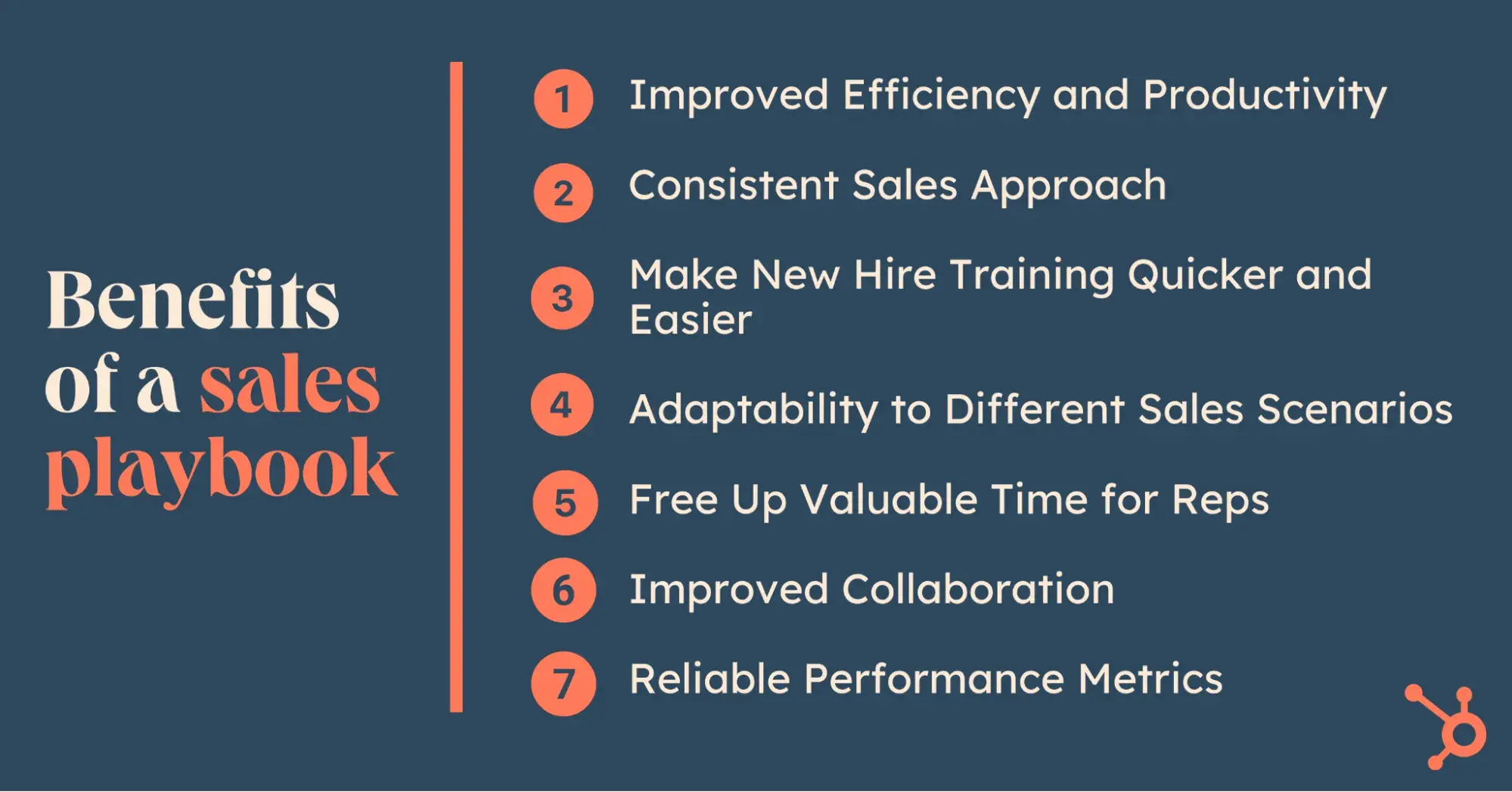
1. Improved Efficiency and Productivity
It helps streamline the sales process by providing a clear roadmap for sales representatives to follow. This structured approach allows them to spend more time actively selling and less time figuring out what to do next.
Additionally, having all the necessary information and resources readily available allows your sales reps to work more efficiently and handle a higher volume of leads.
2. Consistent Sales Approach
A sales playbook codifies your most effective strategies, ensuring that every team member has access to proven techniques. This standardization leads to more consistent performance across your sales force.
3. Make New Hire Training Quicker and Easier
From my experience, training new salespeople is far quicker and easier when you have clear, explicit explanations of who your customers are, how they buy your products, what pain points they experience, what to say to them, and more.
Without a sales playbook, your reps are forced to learn this information ad hoc.
4. Adaptability to Different Sales Scenarios
A well-designed sales playbook includes various “plays” or strategies for different sales situations. This adaptability allows sales reps to navigate complex sales scenarios with confidence, whether they're setting up an initial meeting or restarting a stalled proposal.
It provides guidance for multiple scenarios and empowers your team to handle diverse challenges effectively.
5. Free Up Valuable Time for Reps
According to HubSpot's 2024 State of Sales Report, sales reps spend only 33% of their day actually selling.
When sales reps spend too much time searching for or creating content, they can’t focus on nurturing deals and closing sales. That's the power of a playbook; it frees up time for selling.
Rather than having each rep develop their own messaging, questions, and resources to use with prospects, give them ready-made content — a.k.a, focus on sales enablement. This will give your reps more time to sell.
6. Improved Collaboration
With a centralized document outlining the sales process, team members from both sales and marketing teams can collaborate more effectively. The playbook fosters a shared understanding of goals and strategies, enabling sales reps to work together seamlessly. This collaborative environment can lead to more innovative solutions and a stronger, more cohesive sales team.
7. Reliable Performance Metrics
A sales playbook provides a framework for tracking and analyzing key performance indicators (KPIs). You can quickly use this data to identify areas for improvement, measure the effectiveness of different strategies, and make informed decisions to optimize the sales process.
This data-driven approach ensures that your team is always working towards the most effective methods for achieving their targets.
Sales Plays to Include in Your Playbook
I've seen themes create sales plays for a specific stage of the sales pipeline. I've also seen plays just for demos, which has helped reps with presenting, asking the right questions, and handling objections. These are some examples of plays that you may choose to focus on.
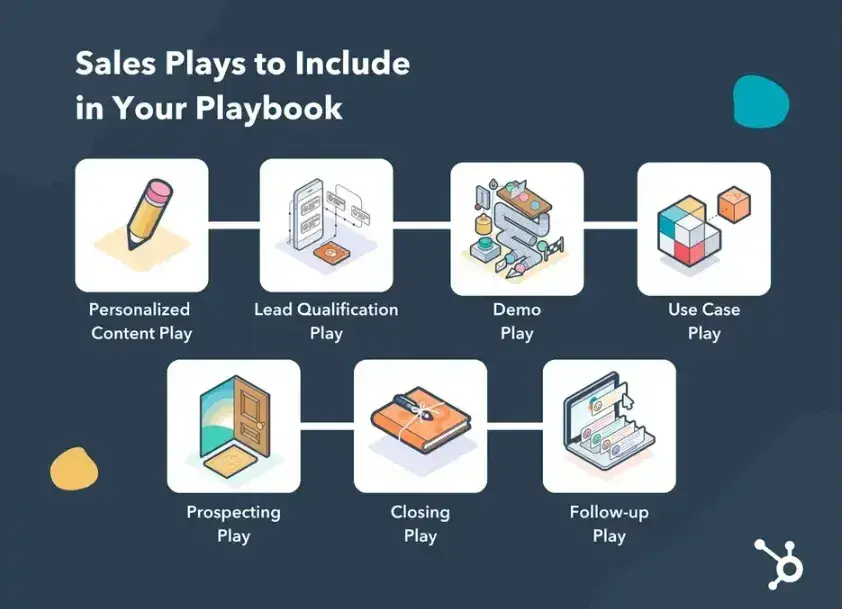
- Personalized content play. Describe how reps can personalize and tailor the content they share with prospects and customers to the buyer's journey.
- Lead qualification play. This play should define how reps can efficiently identify high-qualified leads to reach out to.
- Demo play. Focus this play on how reps can effectively demo products and how to strategically highlight their features and benefits to prospects.
- Use case play. This play should showcase specific use cases that your existing customers have reported as how they get the most out of your products.
- Prospecting play. Focus this play on how reps can use certain platforms, channels, or tactics to identify prospects that meet your ideal customer profile (ICP).
- Closing play. Focus this play on how reps can move late-stage leads towards closing in a way that feels natural, professional, and effective.
- Follow-up play. Focus this play on how and when reps can follow up with leads at different points in the buyer's journey, including after the sale, to ensure all of a customer’s needs are met.
Winning Tips for Crushing Q4 Sales Goals
Before we dive into some playbook examples, here are five plays I used to run in Q4 to optimize my chances of closing as many deals as possible.
1. Don’t be surprised by OOO replies.
Ask the prospect what their vacation schedule is if they suggest they will be buying in the last quarter. See if they have anyone backing them up while they are on vacation or if there are any procurement counterparts that might submit the deal. Ask for a verbal commitment on a Q4 deal for forecast accuracy.
2. Understand and leverage year-end budgets.
Does a prospect’s fiscal year end in December, March, or some other time of the year? Many businesses over budget for costs like technology and equipment, and if they don’t spend the money, it doesn’t roll over to next year.
Find ways to incentivize end-of-year purchases with volume or bundle pricing that won’t devalue your products.
3. Create a sense of urgency.
Does your company plan on price increases in the new year? Are there discounts available for this year’s models to clear aging inventory in your warehouse? Find ways to motivate prospects and existing customers to buy now — not next year.
4. Separate tire kickers from the hot prospects.
Do you have stagnant prospects in your pipeline that haven’t been responsive in recent months?
Brainstorm on incentive packages for leads that have cooled. If emails have gone unanswered, make a call or send a social media message. Maybe the contact left the company or changed responsibilities and can help you find their replacement.
Alternatively, send a break-up email to suggest you will prioritize your attention elsewhere. When you set a prospect free and they return to you with open arms in Q4, it’s often a good sign.
5. Make exclusive or personalized offers.
Many business decision-makers are too accustomed to Q4 limited-time discounts that they simply ignore them.
If your company has a customer success or training program, offer an education incentive to help your team ramp up on your products in the new year. If that training program happens at a customer conference in February, bundle in some conference passes as I’ve done in the past. Training is a great way to help customers get travel approval, especially for a company growth initiative or for training on technology.
The end of the year and the arrival of winter makes many prospects complacent, or they can get caught up with other responsibilities. These tips will help you identify ways to recapture their attention, create urgency, and submit a deal that moves the needle on your year-end revenue attainment.
Sales Playbook Examples
While sales playbooks are typically internal documents, some companies publish their playbooks. Check out a few of my favorites below.
1. HubSpot and Join.me Sales Meeting Playbook
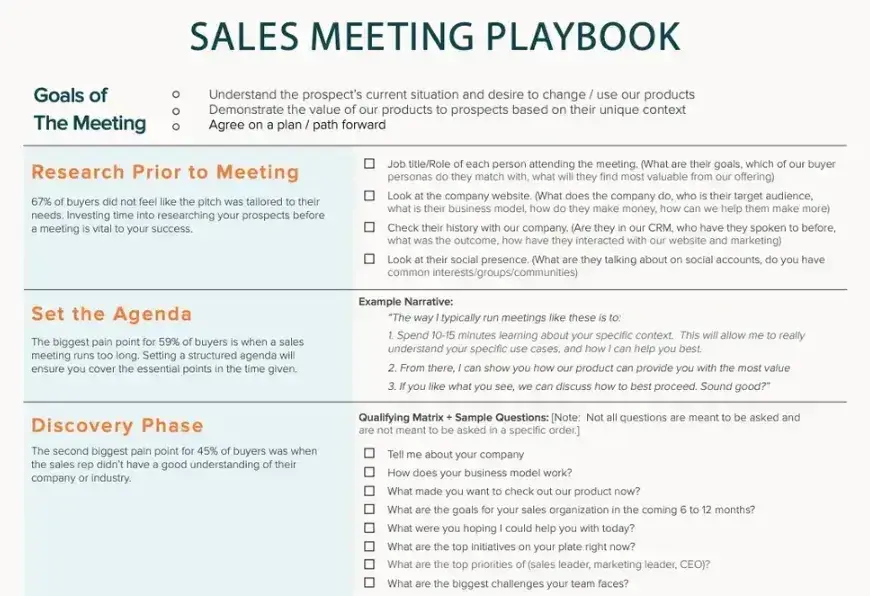
This two-page playbook was created in a joint effort between HubSpot and Join.me. It outlines what a rep should do before and during a sales meeting to increase the chances of closing the sale.
The playbook is divided into seven sections in the sales playbook software — but don’t let that number fool you. With its clear headings and easy-to-scan checkboxes, the seven sections fly by quite quickly. In order, they are as follows.
- Research prior to meeting. Offers guidance on exactly what sales reps should research before the meeting.
- Set the agenda. Includes an example of how sales reps can set the agenda for the meeting.
- Discovery phase. Lists out a few questions reps can ask to uncover information about the prospect’s business, as well as their needs.
- Assess the need. Includes additional questions to diagnose the problem and understand what can be improved.
- Define their buying process. Includes more questions sales reps can ask to understand the client’s purchasing process.
- Demo. Offers a few tips on how to carry out a demo that closes the deal.
- Close. Share an example of what sales reps can say to finish the conversation and win the deal.
Why I think this sales playbook works: The power of this playbook lies in its length. It shows that you don’t need to write a 27-page-long manifesto. With just a few quick bullet points, you can still guide your reps to success. Most importantly, I love that the playbook provides examples of what sales reps can say.
2. Global Telecom Solutions Partner Playbook
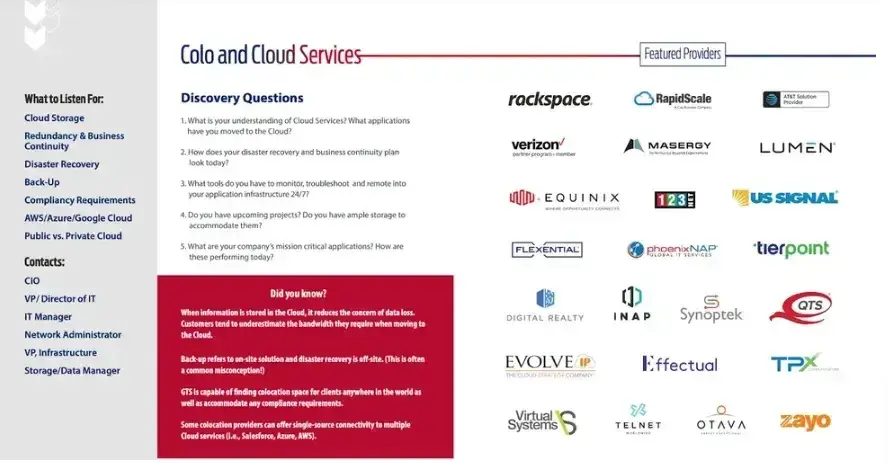
Global Telecom Solutions uses this well-structured sales playbook to provide discovery questions and tips to their solution partners.
It isn't too prescriptive, which is why it’s so effective. Every spread is dedicated to one type of customer, and each has four noteworthy sections.
- Discovery questions. Includes the questions each sales rep should ask prospects in that specific industry.
- What to listen for. Lists a few keywords and terms sales reps should listen for in the prospects’ answers.
- Contacts. Outlines who sales reps should reach out to at the target businesses.
- Did you know. Includes pieces of information that emphasize the importance of GTS’s solutions.
Why I think this sales playbook works: I like that the structure is easy to follow, with every spread dedicated to a different type of customer. It also provides useful goalposts but isn’t overly prescriptive, allowing sales reps to shift gears if need be.
3. Cobalt Iron Partner Playbook
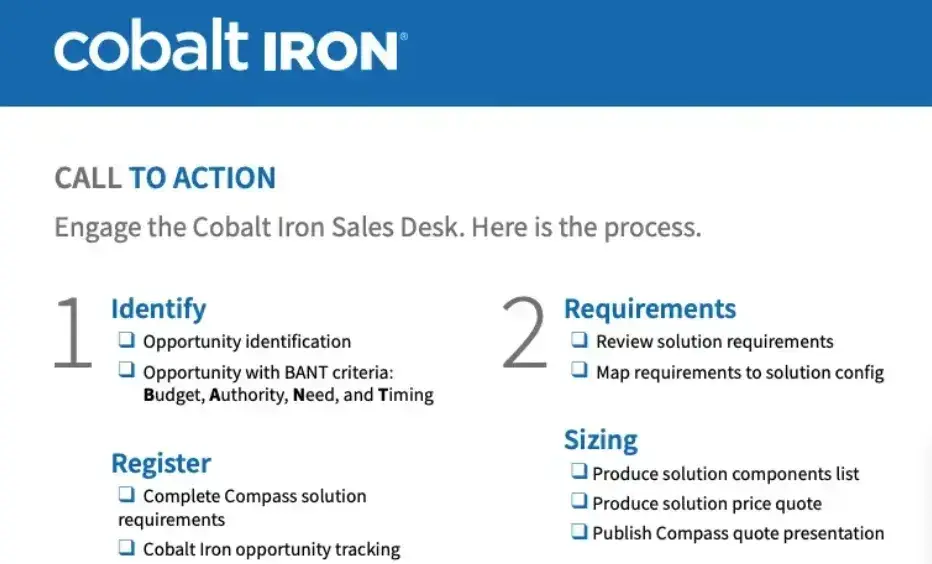
Cobalt Iron’s playbook for its partners is a classic example of a well-executed playbook. It provides an overview of the company and the product, then shares several elevator pitches that partners could use.
It also provides information on the state of the industry so that partners can understand where the product falls in the current landscape.
Notable sections include the following.
- Elevator pitch for customers. Outlines common issues that customers face and reasons why customers should adopt the solution.
- Customer challenges. Gives further insight into the customers’ needs, then goes into specific challenges as they relate to the product.
- Target customer profile. Outlines the characteristics of a customer who needs the product.
- Buyer profile. Offers more details on specific buyer personas at prospective businesses.
- Managing objections. Share common objections and ways to respond to them.
- The competition: Includes easy-to-scan bullet points on how to compare the product to competitors’ offerings.
- Conversation starters. Offers a few questions solutions partners can use to get the conversation rolling.
Why I think this sales playbook works: I like that this playbook is thorough, comprehensive, and well-thought-out. It includes extensive information on the state of the industry and the challenges that prospective customers face. It‘s on the longer side, but there’s a good chance your reps won't mind if it helps them meet their quota.
4. Sales Datanyze and HubSpot Sales Development Playbook (SDR)
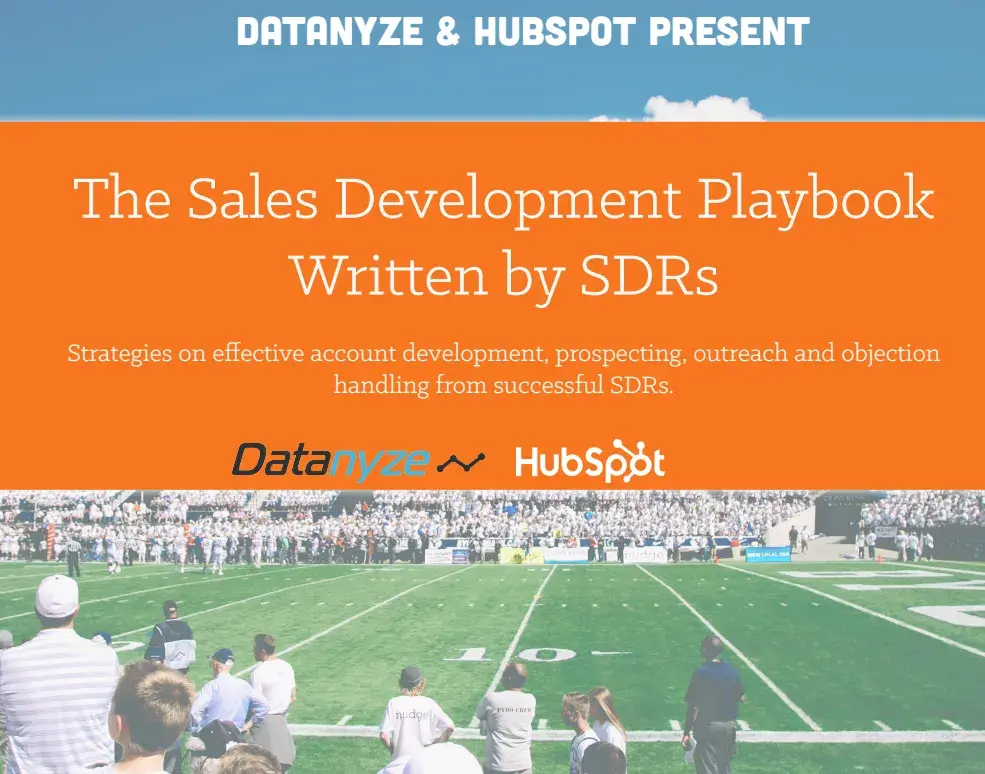
Datanyze and HubSpot created a playbook for sales development eps (SDRs) to become more efficient at account development and outreach. This SDR sales playbook acts as a guide to help SDRs combine automation and advice from seasoned professionals to provide reps with best practices on how to seek out ideal clientele at higher success rates.
This playbook provides several examples of prospect exchanges across email and calls to better equip SDRs for taking sought-after prospects down the sales funnel.
Notable sections of this playbook include the following.
- Account development. Guides SDRs on how to create and manage a named account list for ideal buyers.
- Research and prospecting. Covers how to perform targeted research and find the right contacts.
- Cold emailing. Shares insight on how to humanize emailing and break through cluttered inboxes.
- Calling tips. Demonstrates how to use modern calling tips in outreach strategy.
- Call mapping. Outlines who to conduct calls without jumping into the pitch immediately.
- Objection handling. Lists common objections and how to tactfully approach them.
- Reporting: Emphasizes the importance of tracking performance metrics to gauge effectiveness.
Why I think this sales playbook works: In my opinion, this playbook is the right mix of technical instruction and anecdotal advice to create an easy-to-understand guide to client outreach. It allows SDRs to think about how their interactions can organically and inorganically nurture target audience members. The team can then reel them in with personalized experiences at every step.
Creating a Sales Playbook Destined to Be Indispensable
The key to success in the last quarter of the year lies in preparation, adaptability, and strategic execution. A robust sales playbook can help increase efficiency in your team and improve close rates across the board. Thankfully, a good sales playbook can help you simplify the entire process of creating a playbook.
Once created, don’t let the document stagnate. Stay flexible and be ready to adjust your approach based on real-time feedback and results. Gather feedback from across the sales team to ensure it is useful, realistic, and complete. Encourage your team to recommend updates or new chapters that will add value. Even though coaches, captains, and quarterbacks tend to have the strongest influence over sports playbooks, sales playbooks should have input from your entire sales team.
Refer to and use the steps I covered and the templates I provided to help you along the way. Remember, the goal isn't just to close out the year strong but to lay the groundwork for sustainable growth.
Sales playbook






